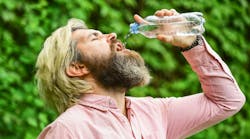Xerostomia through a pandemic: Considerations for clinicians, patients, and the general population
In the last 18 months, dental professionals have become uniquely aware of COVID-19 symptoms, transmission routes, and infection control guidelines to follow in our practices. We know that loss of taste is a widely reported oral manifestation of the virus, but what about xerostomia? Before the emergence of the coronavirus, an estimated 22% of the global population experienced xerostomia.1 We may have already sensed an increase in patient reports chairside, but what do the numbers say? How do the SARS-CoV-2 virus and its treatment alter the salivary health of those infected? How might other pandemic-related circumstances contribute to xerostomia in our communities?
We remember well the multitude of oral conditions at increased risk from hyposalivation: dental caries, hypersensitivity, periodontal diseases, oral fungal infections, acid erosion, and burning oral tissues.2,3We therefore need a thorough understanding of the causes (direct and indirect), prevalence, and treatment modalities for xerostomia more than ever before.
Direct xerostomia contributors
First we’ll examine direct xerostomia contributors from SARS-CoV-2 and its treatment. Up to 56% of COVID-19 patients report xerostomia,4 which precedes other symptoms up to 74% of the time.5 Of course, viral infections in general are known to cause xerostomia,6 but the route of infection for this virus is worth a closer look. It turns out the angiotensin-converting enzyme (ACE) receptors on salivary cells are the primary binding site for the coronavirus; subsequently, these cells become “incubators” of the virus.6
The resulting compromise in salivary flow and composition from these altered glands constitutes hyposalivation and can lead to xerostomia. Fortunately, these cases subside with (or soon after) acute infection. Treatments for SARS-CoV-2 usually don’t cause xerostomia; the use of ventilators for more than 48 hours, however, can.7 As such, recovering COVID patients may experience periods of dryness after discharge from hospital care.
Circumstantial factors
Next, we’ll consider circumstantial pandemic-related factors influencing oral dryness. The most obvious may be the routine and extended use of masks. Most wearers don’t sufficiently hydrate during use and tend to breathe improperly, in short, shallow patterns through their mouths. As hygienists, we can attest to this truth in our own working lives.
Less obvious contributors include stress and anxiety. Our central nervous systems influence salivary production; most notable is restricted salivary flow during periods of acute anxiety.8 Neurohormones also affect our salivary outputs, so disruptions in our circadian rhythms and sleep patterns can also decrease salivary health.9 In fact, there is an established positive correlation in case studies between both stress and anxiety to hyposalivation and xerostomia.9 Pandemic-related stressors have surely exacerbated these physiological effects. Issues such as social restrictions, job losses, child care or schooling challenges, financial strains, restricted health-care access, medical bills for COVID patients, and even loss of loved ones or potential homelessness are arising for countless members of our communities, many of whom may not have faced these hurdles before.
Overall, although there are no firm statistics on global xerostomia since the start of the COVID-19 pandemic, we can surmise with relative ease that it’s more prevalent. But what does all of this mean for us as oral health-care providers? What changes to our care might be indicated to accelerate our patients’ recoveries?
Increase testing for more accuracy
One consideration for our patients with new, unexplained xerostomia is to suggest COVID testing, since it’s now understood to be one early sign of infection. This is most likely a departure from our past responses to patient reports of xerostomia but could prove integral in stopping the chain of infection in that patient’s family or social circle. We may also need to increase their recare intervals and/or radiograph frequencies. This may seem abrupt or unusual to some of our established patients, so we‘ll need to clarify the necessity and estimated duration of these changes as well.
During oral cancer screenings, we should be on the lookout for any signs of salivary changes or their effects, such as fungal infections. Perhaps most important, we should proactively recommend and provide same-day adjuncts whenever beneficial (and as directed by our doctors). These may include chairside desensitizers for hypersensitivity, professional fluoride applications for erosion and caries risk reduction, silver diamine fluoride for early carious lesions in hard-to-restore locations, and prescription dentifrices with dry mouth formulations.
In addition to changes in our clinical care, our OHI should be retailored for each patient’s unique oral challenges as they arise. We should of course recommend dietary adjustments to alleviate xerostomia, such as increased water intake, decreased acid intake, products to stimulate or replace saliva, bedside humidifiers to decrease overnight dryness and improve sleep quality,10 fluoride rinses for remineralization, and more. Specifically, we should be well versed on appropriate xerostomia products for home use. It is worth mentioning here that many of those products are actually pH-lowering and can limit the buffering ability of the saliva, so we need to research and select products that will maintain balanced pH levels in the mouth. Extra time to describe causes and home care for these manifestations may be necessary; we may find ourselves in need of restructured instruction for these more specific COVID-related contributors.
The silver lining in this unprecedented era of uncertainty is this: while we may not be able to shelter our patients from everything a global pandemic may throw their way, we can eliminate some discomfort for them. We can approach each case and its risk factors with well-informed management plans and assure them that they have a partner in these efforts. We can also say we have been sharpened in our ability to assess and manage hyposalivation and to understand its link to viral pathogens, hormonal processes, and neurological responses.
Editor's note: This article appeared in the September 2021 print edition of RDH.
References
1. Agostini BA, Cericato GO, Silveira ERD, et al. How common is dry mouth? Systematic review and meta-regression analysis of prevalence estimates. Braz Dent J. 2018;29(6):606-618.
2. Borgnakke WS, Taylor GW, Anderson PF, Shannon MC. Dry mouth (xerostomia): Diagnosis, causes, complications and treatment. Oral and general health–Exploring the Connection. Research Review 2011. Delta Dental Plans Association; 2010. Accessed July 8, 2020. https://www.nedelta.com/SiteMedia/SiteResources/downloads/Forms%20for%20All/Dry_Mouth_Research.pdf
3. Pedersen AML, Sørensen CE, Proctor GB, Carpenter GH, Ekström J. Salivary secretion in health and disease. J Oral Rehabil. 2018;45(9):730-746. doi:10.1111/joor.12664
4. Biadsee A, Biadsee A, Kassem F, Dagan O, Masarwa S, Ormianer Z. Olfactory and oral manifestations of COVID-19: sex-related symptoms—a potential pathway to early diagnosis. Otolaryngol Head Neck Surg. 2020;163(4):722-728. doi:10.1177/0194599820934380
5. Fantozzi PJ, Pampena E, Di Vanna D, et al. Xerostomia, gustatory and olfactory dysfunctions in patients with COVID-19. Am J Otolaryngol. 2020;41(6):102721. doi:10.1016/j.amjoto.2020.102721
6. Saniasiaya J. Xerostomia and COVID-19: Unleashing Pandora's box. Ear Nose Throat J. 2021;100(2_suppl):139S. doi:10.1177/0145561320960353
7. Hua F, Xie H, Worthington HV, Furness S, Zhang Q, Li C. Oral hygiene care for critically ill patients to prevent ventilator-associated pneumonia. Cochrane Database Syst Rev. 2016;10(10):CD008367. doi:10.1002/14651858.CD008367.pub3
8. Proctor GB. The physiology of salivary secretion. Periodontol 2000. 2016;70(1):11-25. doi:10.1111/prd.12116
9. Gholami N, Hosseini Sabzvari B, Razzaghi A, Salah S. Effect of stress, anxiety and depression on unstimulated salivary flow rate and xerostomia. J Dent Res Dent Clin Dent Prospects. 2017;11(4):247-252. doi:10.15171/joddd.2017.043
10. Hay KD, Morton RP. Optimal nocturnal humidification for xerostomia. Head Neck. 2006;28(9):792-796. doi:10.1002/hed.20419
Michelle MacLean, RDH, is a full-time clinical hygienist in a general practice near Lawrenceville, Ga. She has created and implemented practice protocols compliant with the 2017 World Workshop on Periodontal Diseases and Conditions. She is also a real estate investor and is in real estate school. She is married with a 5-year-old daughter, and is in the process of opening her home to children in need of foster care. She can be reached at [email protected].







